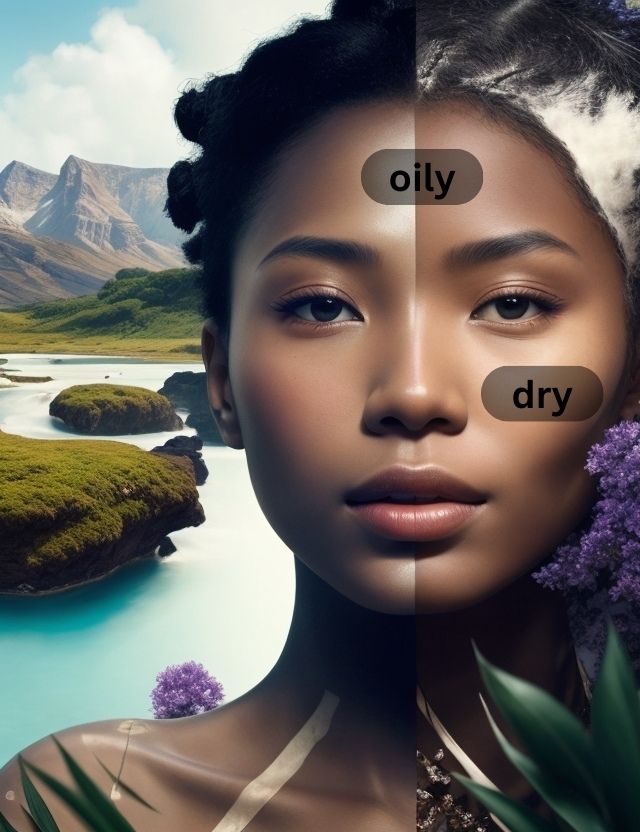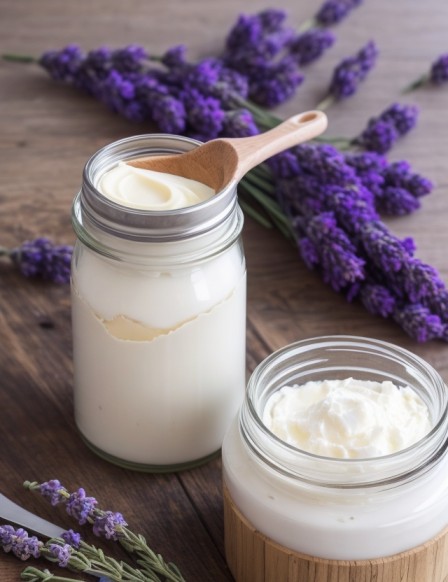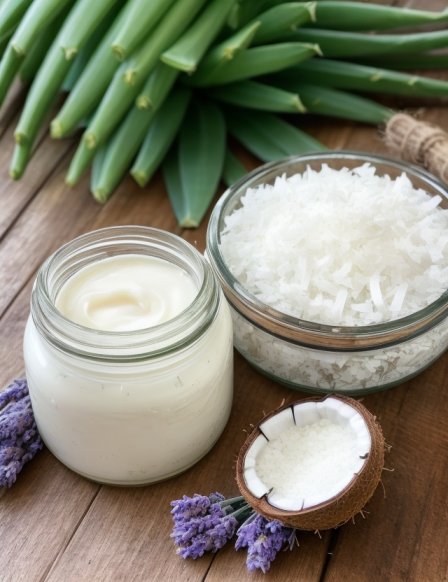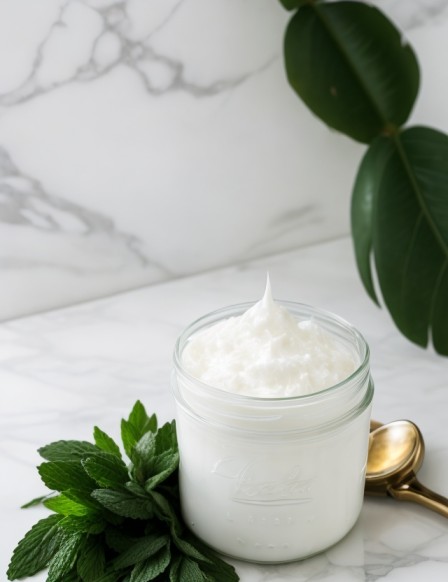Keeping our skin well-hydrated is a crucial step in maintaining its health and radiance. However, finding the perfect body lotion that suits our skin type can be quite challenging. Commercial products often contain chemicals that may not align with our skin’s needs. Thankfully, there’s a natural and customizable solution: homemade body lotions!
In this blog post, we’ll explore the wonderful world of DIY hydrating body lotions using shea butter, coconut oil, and essential oils. These natural ingredients offer a range of benefits and are suitable for all skin types. Let’s dive in and discover how to achieve moisturized and supple skin the natural way.
Understanding Your Skin Type in Detail
The first step in developing an efficient skincare routine that meets your skin’s specific needs is understanding your skin type. Understanding your skin type will help you choose the right products, including hydrating body lotions, to keep your skin healthy and radiant. There are generally five main skin types: normal, oily, dry, combination, and sensitive. Let’s examine each type of skin to assist you determine which group your skin belongs to:
1. Normal Skin:

Normal skin is a blessing that many desire. It is a well-balanced skin type that neither leans towards excessive oiliness nor extreme dryness. People with normal skin typically enjoy a smooth and even complexion with tiny, barely visible pores. This skin type is characterized by the right amount of sebum production, keeping the skin adequately moisturized without feeling greasy or tight. Individuals with normal skin usually have few blemishes, and their skin tone remains consistent throughout. One of the advantages of having normal skin is that it is less prone to sensitivity or irritations. However, even with this well-balanced canvas, proper skincare remains crucial to maintain its youthful radiance. Regular cleansing, moisturizing, and sun protection are essential to preserve the natural balance and keep normal skin looking healthy and glowing.
2. Oily Skin:

If you have this skin type, you know that excess sebum production is a constant companion. Oily skin appears shiny, particularly in the T-zone, which includes the forehead, nose, and chin. The enlarged pores can sometimes be a cause for concern as they tend to trap dirt and impurities, leading to acne and blackheads. However, it’s not all bad news! Oily skin has its perks; it tends to age more slowly due to the natural moisture barrier. To manage oily skin, it’s essential to strike the right balance. Gentle cleansing is crucial to remove excess oil without stripping the skin. Opt for non-comedogenic and oil-free moisturizers that won’t clog pores. Incorporating ingredients like salicylic acid can help control oil production and keep breakouts at bay. Embrace your skin’s natural glow and take care of it with a consistent skincare routine tailored to your oily skin’s unique needs.
3. Dry Skin:

Dry skin can be a challenging companion on your skincare journey. If you have this skin type, you know the struggle of dealing with tightness, flakiness, and a dull complexion. Dry skin occurs when the skin lacks sufficient natural oils, which are essential for maintaining moisture and hydration. As a result, it may feel parched and dehydrated, especially in harsh weather conditions. The lack of oil can also accentuate fine lines and make the skin more sensitive. To combat dryness, a consistent and hydrating skincare routine is essential. Look for rich and nourishing moisturizers that contain ingredients like hyaluronic acid and glycerin to help retain moisture. Avoid harsh cleansers and hot water, as they can further strip the skin of its natural oils. Regular exfoliation can help remove dead skin cells and improve the skin’s texture. Embrace your skin’s unique beauty and pamper it with the love and care it deserves.
4. Combination Skin:

Ah, the ever-confusing combination skin! If you have this skin type, you know the struggle of dealing with both oily and dry areas on your face. Combination skin is a mix of different skin types, usually characterized by an oily T-zone (forehead, nose, and chin) and drier cheeks. Finding the right skincare routine can be a bit challenging, but fear not! There are ways to achieve balance. Gentle cleansing is vital to remove excess oil in the T-zone without over-drying the cheeks. Look for lightweight, non-greasy moisturizers to hydrate the dry areas without causing breakouts. Using a toner can help regulate sebum production and keep the skin’s pH levels in check. It may take some trial and error, but with a tailored routine, you can achieve harmony and embrace the beauty of your combination skin. Remember, it’s all about finding the right balance for your unique skin needs!
5. Sensitive Skin:

Having sensitive skin can feel like navigating a delicate terrain. If you have this skin type, you know that it’s easily irritated and reactive to various skincare products and environmental factors. Sensitive skin can manifest as redness, itchiness, and discomfort, making it challenging to find suitable products. However, with the right approach, you can still pamper and care for your skin. Look for products labeled as hypoallergenic and free from harsh chemicals or fragrances. Perform patch tests before applying new products to your face and choose gentle, soothing ingredients like aloe vera and chamomile. Keep your skincare routine simple and avoid over-exfoliating or using harsh treatments. Protect your skin from the sun with broad-spectrum sunscreen and always consult a dermatologist for personalized advice. Embrace your skin’s unique sensitivity and treat it with gentle love and attention.
To determine your skin type, follow these steps:
- Wash your face with a mild cleanser and pat it dry.
- Wait for about an hour without applying any skincare products.
- Observe how your skin feels and looks:
- Normal skin will feel balanced, with no excessive oiliness or dryness.
- Oily skin will appear shiny and feel greasy, especially in the T-zone.
- Dry skin may feel tight and look flaky or dull.
- Combination skin will have a mix of characteristics, with oiliness in the T-zone and dryness in other areas.
- Sensitive skin may show signs of redness or irritation upon exposure to certain products or stimuli.
Once you identify your skin type, you can choose the right skincare products, including hydrating body lotions, that address your specific needs. Regularly evaluating your skin type and adjusting your skincare routine as needed will help you maintain healthy, glowing skin for the long term.
Shea Butter: The Nourishing Base
Shea butter is a true skincare gem. Extracted from the shea tree nuts, it boasts an array of nourishing properties. Rich in vitamins A, E, and fatty acids, shea butter deeply moisturizes the skin, promoting elasticity and a youthful glow. When choosing shea butter, opt for raw and unrefined varieties to maximize its benefits.
DIY Shea Butter Body Lotion Recipe

Ingredients:
- 1/2 cup raw shea butter
- 2 tbsp carrier oil (e.g., jojoba oil or almond oil)
- 10-15 drops of your favorite essential oil (optional)
Preparation:
- Gently melt the shea butter using a double boiler.
- Once melted, add the carrier oil and essential oil (if using) and stir thoroughly.
- Allow the mixture to cool slightly before transferring it to a clean container.
- Let the body lotion solidify entirely before applying it to your skin.
Coconut Oil: The Moisturizing Marvel
Another superstar in the realm of natural skincare is coconut oil. Packed with emollient properties, coconut oil helps lock in moisture and repair the skin’s barrier. It’s also known for its antibacterial and antifungal qualities, making it an excellent choice for acne-prone or irritated skin.
DIY Coconut Oil Body Lotion Recipe

Ingredients:
- 1/2 cup organic coconut oil
- 2 tbsp aloe vera gel
- 10-15 drops of lavender essential oil (or your preferred scent)
Preparation:
- In a mixing bowl, combine the coconut oil and aloe vera gel.
- Add the essential oil and mix well to create a smooth, fragrant lotion.
- Transfer the mixture to a clean container and store it in a cool, dry place.
Essential Oils: Adding Fragrance and Therapeutic Benefits
Essential oils not only infuse your body lotion with delightful scents but also offer various therapeutic benefits for your skin and overall well-being. However, it’s essential to use them safely and properly. Always dilute essential oils in carrier oils before adding them to your lotions.
Customizing Your Body Lotion with Essential Oils
To add a pleasant fragrance and enhance the therapeutic properties of your body lotion, consider using essential oils like:
- Lavender: Soothes and calms the skin, ideal for sensitive or irritated skin.
- Geranium: Balances oil production, suitable for combination skin.
- Frankincense: Promotes skin cell regeneration, great for mature skin.
- Tea Tree: Possesses antibacterial properties, beneficial for acne-prone skin.
Bonus: Luxurious Whipped Body Lotion
If you want to indulge in a light and airy body lotion experience, try making a whipped version. Whipped body lotions have a fluffy texture, making them easy to apply and absorb quickly into the skin.
DIY Whipped Body Lotion Recipe

Ingredients:
- 1/2 cup shea butter
- 1/4 cup coconut oil
- 1/4 cup jojoba oil
- 15 drops of your favorite essential oil blend
Preparation:
- In a mixing bowl, combine the shea butter, coconut oil, and jojoba oil.
- Use a hand mixer to whip the mixture until it becomes light and fluffy.
- Add the essential oil blend and whip again to incorporate the fragrance.
- Transfer the whipped lotion to a clean, airtight container.
Also Read-
- Simple Homemade Face Mask Recipes
- 7 Tips for Keeping Your Skin Hydrated and Fresh During Long Flights
Tips for Storing and Using Homemade Body Lotions
To ensure your DIY body lotions stay fresh and effective, follow these tips:
- Store your lotions in dark, glass containers to preserve their potency.
- Keep them in a cool, dry place away from direct sunlight.
- Perform a patch test before applying the lotion all over your body, especially if you have sensitive skin.
- Remember that natural products have a shorter shelf life, so make smaller batches and use them within a few months.
FAQs (Frequently Asked Questions)
Q1: Why should I consider making DIY body lotions?
DIY body lotions allow you to use natural, nourishing ingredients tailored to your skin type, avoiding harmful chemicals found in commercial products.
Q2: Are these DIY lotions suitable for all skin types?
Yes, the recipes are versatile and can be adapted for normal, oily, dry, combination, and even sensitive skin types.
Q3: Can I use these lotions on my face as well?
While some ingredients are safe for facial use, it’s best to avoid using body lotions on the face, as facial skin is more delicate and requires specific formulations.
Q4: What is the shelf life of these homemade lotions?
Homemade lotions typically have a shelf life of 3 to 6 months. Store them in a cool, dark place to extend their freshness.
Q5: How do I know which essential oils to use?
Choose essential oils based on your skin’s needs. For example, lavender soothes, while tea tree oil helps with acne-prone skin.
Q6: Can I adjust the fragrance of the lotions?
Absolutely! Feel free to customize the scent by adding more or fewer drops of essential oils, creating your signature aroma.
Q7: Can these lotions help with skin conditions like eczema?
Shea butter and coconut oil possess moisturizing properties that can benefit dry skin conditions like eczema. Consult a dermatologist for personalized advice.
Q8: Can I use other carrier oils in the recipes?
Yes, you can experiment with different carrier oils like almond, argan, or avocado oil, based on your preferences and their suitability for your skin.
Q9: Can I gift these homemade lotions to others?
Absolutely! DIY body lotions make thoughtful and personalized gifts for friends and loved ones, showcasing your care and creativity.
Q10: Can children use these lotions?
For children and babies, it’s best to use simple and gentle ingredients like shea butter and coconut oil. Always do a patch test and consult a pediatrician if unsure.
Conclusion
Pampering your skin with homemade body lotions is a rewarding and enjoyable journey. Shea butter, coconut oil, and essential oils offer a plethora of benefits, and their versatile nature allows you to create personalized concoctions tailored to your skin’s needs. Embrace the power of natural ingredients and elevate your skincare routine to achieve a radiant and hydrated complexion. So, go ahead, unleash your creativity, and indulge in the art of DIY body lotions! Your skin will thank you for it.

